Scoutmaster Musings
Archives:
2025 - Jan
2023 2022 2021 2020 2019 2018 2017 2016 2015 2014 2013 2012 2011 2010 2009 2008 2007 2006 2005
Natl Outdoor Badge Tracking
 To help scouts keep track of the various requirements of miles, nights, hours, and adventures for the National Outdoor Badge awards, I've created some documents.
To help scouts keep track of the various requirements of miles, nights, hours, and adventures for the National Outdoor Badge awards, I've created some documents.Hopefully, they'll make the broad range of requirements more manageable for your scouts.
See the National Outdoor Badges page for the PDF files.
Scout ON
| Leave Comment |
Posted: 16:17 09-27-2010 524
Quack Quack
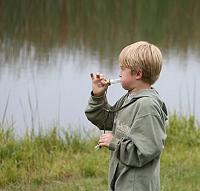 There's not a hunting merit badge yet, but that doesn't mean scouts can't excel at hunting skills.
There's not a hunting merit badge yet, but that doesn't mean scouts can't excel at hunting skills.A Webelos scout is the winner of the inaugural duck calling contest at Whittlesey Creek National Wildlife Refuge, WI. He completed a 3-day waterfowl course at the refuge and then entered the calling competition.
The course is for 10-15 year old hunter-certified youth to learn waterfowl identification by sight and sound, silhouette, wing beats, flock patterns and behavior.
The contest included these calls: long-distance call, mating call, feeding call and comeback call. The emphasis is on difficulty, accuracy and repetition.
Read More
Scout On
PS: The scout is my nephew. :-)
| Leave Comment |
Posted: 7:30 09-24-2010 523
BSA Uniforms
 Somebody at BSA learned Flash programming this summer. The new bsauniforms.org site takes you on a fun-filled, whirlwind tour of uniforming from Tiger Cub through Scout Leader. Hold onto your hats and watch your little scout spin in circles and walk across your screen. Wow!
Somebody at BSA learned Flash programming this summer. The new bsauniforms.org site takes you on a fun-filled, whirlwind tour of uniforming from Tiger Cub through Scout Leader. Hold onto your hats and watch your little scout spin in circles and walk across your screen. Wow!Cute, but I don't see the value in weird music, spinning, stumbling scouts, and dragging patches to shirts. The best part of this extravagant, interactive experience is the link to Documents on scoutstuff.org which has the useful, printable patch placement sheets with pictures AND text.
Can't help but wonder how much we all collectively spent on this one. :-(
Scout On
| Leave Comment |
Posted: 14:59 09-21-2010 522
Americana
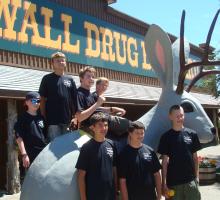 After every driving trip the troop takes 'out west', I swear to myself that's the LAST time we stop at Wall, South Dakota! But, when it comes round to planning the next long-distance trek Wall Drug always gets listed as a place the scouts decide to stop.
After every driving trip the troop takes 'out west', I swear to myself that's the LAST time we stop at Wall, South Dakota! But, when it comes round to planning the next long-distance trek Wall Drug always gets listed as a place the scouts decide to stop.Unfortunately, it winds up usually being a convenient gas stop so I've got no excuses to skip it. But, man, what a zoo! It's the best place to find license plates, it's always the hottest town across the prairies, and all those Black Hills Gold stores are always going out of business. :-)
You've got to admit, there are some places across the country that just are America, good, bad, or just silly. From the world's largest ball of twine to the world's largest potato, from the first McDonald's to the first baseball diamond, when you're traveling through, how can you skip them?
Sure, after the second or third time seeing a run-down, paint-peeling, antlered rabbit it tends to lose its charm. But, remember it's still the first time for some of the guys and it may be one of the silly things they'll talk about a year later...
probably just about the time when the next trip gets planned.
Scout On
| Leave Comment |
Posted: 22:40 09-10-2010 521
10K Mosquitoes
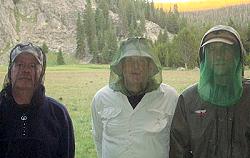 Mosquitoes are a bane to all campers. They can carry disease, they itch, they buzz, they squish, they swarm, they even get in your ears and eyes.
Mosquitoes are a bane to all campers. They can carry disease, they itch, they buzz, they squish, they swarm, they even get in your ears and eyes. I love the first frosts in the fall. Camping in late September and October is my favorite time because the bugs are usually gone. The cold weather takes care of the little pests until the warmth of spring. Plus, humidity and heat tend to be lower.
One would think that at 10,000 feet up a mountain, where trees are sparse, the air is dry, the wind continually blows, and there is frost some mornings in July, a respite from the bloodsuckers could be had. But, no, No, NO!!! The skeeters were thicker and more aggressive than any lowland Minnesota mosquitoes. The only difference is that they were out earlier in the day and laid low once the temperatures dropped with the setting of the sun.
This trek was the first time I've resorted to using mosquito netting, but it did a great job - and what a fashion statement, isn't it?
For thick mosquitoes, wearing long loose-fitting pants and shirt, plus a head net works a lot better than bug repellant. Light nylon pants like the BSA zip-offs work well. Just be careful when you sit and the fabric is pulled tight against your skin because bites can go right through.
| Leave Comment |
Posted: 16:42 09-09-2010 520
A Helping Hand
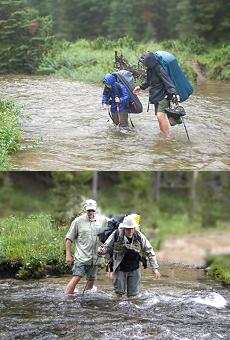 As scoutmaster, I get to witness the development of young men outside the daily routine. Most of the greatest growth I've seen is during times of trial. This past weekend, we had a 'Wilderness Survival' campout with scouts building shelters and sleeping out rather than in tents. Well, with zero rain and beautiful, cool breezes blowing, there's not much challenge in 'surviving' a night. It was fun building and lashing structures, and teamwork was evident, but no urgency to perform was required.
As scoutmaster, I get to witness the development of young men outside the daily routine. Most of the greatest growth I've seen is during times of trial. This past weekend, we had a 'Wilderness Survival' campout with scouts building shelters and sleeping out rather than in tents. Well, with zero rain and beautiful, cool breezes blowing, there's not much challenge in 'surviving' a night. It was fun building and lashing structures, and teamwork was evident, but no urgency to perform was required.People are like teabags - you find out how strong they are when they're in hot water. Most of the time, those teabags are a lot stronger than they ever thought they would be and without the hot water, they would never learn how much they could accomplish.
These are two pictures from our backpacking treks. The top is a young scout three years ago(now an ASPL and Junior in high school) struggling across a rain-swollen river. This was 3/4ths of the way through a 15-mile hike in a miserable day of rain. The bottom is another scout doing his first water crossing this summer.
These two scouts thought they needed help crossing, so I made sure I was there with them, lending support as needed. I'm downstream and a step behind so I could grab them, but not be in their way. I'm not leading them or making the way any easier for them than it was for everyone else. And, when we were across, they understood I hadn't really helped them at all - they made it on their own.
Sometimes a helping hand is one that is just ready and willing, not doing anything. The security of knowing someone is with you can be all that is needed for a scout to push himself and reach goals he just wasn't confident enough to reach alone. "Confident" isn't in the Scout Law, but it certainly is a goal I have for each scout.
Scout On
PS: I'm wearing the same pair of BSA zip-off pants in both pictures - 4 years of hard scouting and they still work.
| Leave Comment |
Posted: 6:46 09-03-2010 519
Bomber Mountain
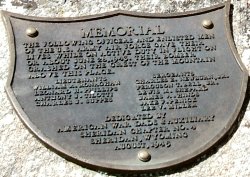 Backpacking can give scouts a great sense of accomplishment at the end of a trek. But, having something more than just mountains and miles to explore can make a trek even more memorable.
Backpacking can give scouts a great sense of accomplishment at the end of a trek. But, having something more than just mountains and miles to explore can make a trek even more memorable.One thing I've found to be of high interest to scouts is discovering wreckage, whether it's old cars, trains, logging camps, or especially airplanes.
Right next to Cloud Peak in Wyoming, you can find Bomber Mountain. In 1943, a plan enroute from Pendleton, OR to Grand Island, NE clipped the top of this mountain ridge and disintegrated across a long stretch of rockfield. Now, it's a day hike from the Misty Moon area to the bomber wreckage. There is a memorial plaque on the shore of Florence Lake below the ridge, as seen in this photo from this summer.
With a little internet research, you can find many plane wreck sites, some of which can make for an interesting hike destination or stop. Scouts might like to plan a trip to see one in your area.
If you do visit a site, please remember that most likely people died there and be mindful of that.
Here's a few samples:
| Leave Comment |
Posted: 18:17 08-25-2010 518
Pictures Work Fine
 It's not every day that you find a rock shaped exactly like your home state! That's something cool to take home and keep forever for a souvenir to rekindle memories of a great trek through the mountains. Besides, it's just one little rock.
It's not every day that you find a rock shaped exactly like your home state! That's something cool to take home and keep forever for a souvenir to rekindle memories of a great trek through the mountains. Besides, it's just one little rock.Now, that's a difficult choice to make in regards to Leave No Trace. Will taking one little rock really impact the experience of any other person that visits the area? Probably not. What are the chances that any other person will ever even see that rock, let alone recognize it looks like Minnesota? Probably zero. Will the rock wilt, rot, or decay once it is taken from the environment and brought home, like a flower, stick, or bone? Nope, it lasts forever.
So, why should a scout follow the LNT principle of "Leave What You Find" and leave the rock where it was found? Well, here's a few thoughts to think:
- A picture weighs nothing - taking the rock means you carry more.
- This picture can be shared around the world on the 'net instead of the rock stashed in a box at home.
- You know the rock is still out there and we might see it on another trek. Or, someone else just might see it someday.
- There are tiny critters living on the rock, even if we can't see them.
In our case, there actually was not much discussion. The rock was found and passed around. I asked what the plan was for the rock and the scouts said they needed to leave it there. They had their expectations set before we even started our trek that we'd be following the Leave No Trace principles to our best ability. So, there wasn't much disappointment at taking a picture and putting it back.
Once the principles are understood and the expectations set, minimizing your impact on treks, campouts, and other outings starts becoming just the new way your group does things. It's not an ongoing struggle of enforcement. But, there is always room for improvement or change in techniques and decisions.
Scout On
| Leave Comment |
Posted: 6:48 08-23-2010 517
Bob the Ranger
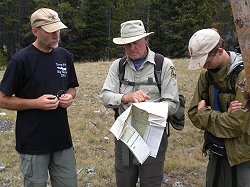 When people are concerned primarily with their own advancement, enjoyment, wealth, and success, even at the expense of others, conflicts are bound to occur. It's common to hear about swindles, robberies, and other similar crimes. We have people in business continually trying to bend or bypass the rules and laws in order to take advantage of someone else.
When people are concerned primarily with their own advancement, enjoyment, wealth, and success, even at the expense of others, conflicts are bound to occur. It's common to hear about swindles, robberies, and other similar crimes. We have people in business continually trying to bend or bypass the rules and laws in order to take advantage of someone else.To combat this greed, there are new regulations constantly being created. And, people trying to find new ways around them.
These regulations are enforced and there are penalties if you get caught. If there was no enforcement then many people would ignore them.
This is where many people get their view of policemen - people that enforce laws and imprison bad guys. But, that is a small part of the service they provide. They also perform first aid, help lost kids, provide information, make people feel safe, and many other good deeds.
In the wilderness, you might meet a wilderness ranger, employed by the US Forest Service or other land management agency. These rangers are similar to police. They have the duty to enforce regulations, such as group sizes, campfire use, and campsite locations. Many people think of them only in this role - the role of enforcer - and therefore are apprehensive when meeting one.
Unfortunately, some of the rangers also see themselves mainly in this role and they promote that confrontational view of the community. I've met a couple of these rangers over the years. They let you know that it's "their" wilderness and your group is visiting, and by gosh you'd better watch yourselves. These rangers must have the worst job in the world - being out in beautiful country but not able to enjoy it because they are too busy looking for "trespassers" causing problems.
On the other hand, there are some rangers like the one I talked to on both my treks this past month. His name is Ranger Bob and he embodied what I think a ranger should be. He checked our permit to make sure we were 'legal'. He asked us our plans and how our hike was going. He pointed out a couple good sites to camp that were well away from other groups - in a way that I understood he wanted us to use them, but not in a forceful authoritarian way. Then, he let me know that fires were prohibited in the wilderness and he appreciated me bringing young guys out to enjoy the countryside.
A few minutes after he left us to continue his hunt for illegal fire sites, he came back and asked if we were interested in viewing some wildlife. He then led us around a small stand of trees to see two moose in the creekbed - moose that two other groups had gone past, completely oblivious. We would have missed them to if he hadn't made the extra effort to point them out.
Now, that's the kind of guy I'd like to be. Someone willing to give advice, share experience, educate visitors in proper techniques, make sure they understand the rules, and provide enforcement only when necessary. Helping folks understand what they should do, why they should do it, and how they should do it best. And, you don't have to be Bob the Ranger to do just that - we should be doing it all the time in Scouting.
Scout On
| Leave Comment |
Posted: 15:34 08-18-2010 516
Any Wilderness Will Do
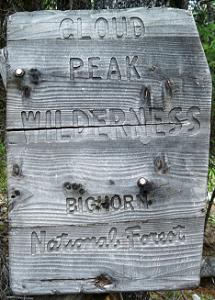 This is the Cloud Peak Wilderness boundary marker, but it could be any wilderness area. We have special regulations and laws when you set foot past that sign. It's necessary because many people still do not appreciate the value of preserving wild spaces.
This is the Cloud Peak Wilderness boundary marker, but it could be any wilderness area. We have special regulations and laws when you set foot past that sign. It's necessary because many people still do not appreciate the value of preserving wild spaces.I'm a pretty strong advocate for the concept of Leave No Trace even though the it's an impossible goal - we always leave some trace as we go through life. I guess I prefer the term Minimize Impact better since I can be successful at that.
Whatever you call it, I think it's important that the Boy Scouts put more effort into integrating and embracing LNT principles. It now appears on many pages of the latest Scout Handbook and is required knowledge and practice for advancing to First Class. But, I wonder how much it is actually promoted and checked for when those requirements are signed off.
Some people feel that Leave No Trace is just for wilderness areas and it's ok to hack, slash, burn, and trample BSA camps. BSA camps that I've visited are great places, but they get a lot of traffic. And, a couple uneducated scouts with a saw, ax, or shovel can do a lot of damage - damage that visitors will see for years.
These BSA camps are perfect training grounds for teaching and practicing how to minimize impact so that treks to Philmont, Northern Tier, or other wilderness areas are demonstrations of skill rather than learning of skill. They aren't wilderness areas, but they'll do just fine for learning. It's not appropriate to take youth to the wilds and then start explaining what Leave No Trace is and how to do it. That should have been done since they first joined the troop so they're ready to make the right environmental decisions on treks.
Making Leave No Trace happen depends highly on the adult leaders and traditions of a troop. If a troop has always had campfires, bathed in streams, tossed out or buried food waste, set up tents on the softest grass, ... then there is a big culture shift needed before they participate in a high adventure trek.
On the other hand, scouts that are used to using backpacking stoves, compressing and carrying out garbage, looking for durable spots for tents and kitchen, digging catholes, and the like will more likely have little problem completing a trek with small sign of their passing.
Our troop is fortunate to have a Leave No Trace workshop offered at least twice a year. From this, we've got a majority of scouts and adults trained in the principles. Having the knowledge makes the practices easier to incorporate into weekend campouts. Scouts look for good tent locations, stay on trails, are careful with food and pick up what they drop, strain wash water, just as a matter of course. Of course, they aren't perfect about it but we practice it and by the time they are old enough to go on any wilderness outing, they have the skills.
Please consider how your troop impacts the wilds. Check with your Council Outdoor Ethics Advocate to arrange a Leave No Trace workshop or see if you can get a scout and an adult to attend a Leave No Trace Trainer class. If you have an LNT Trainer, then he can present workshops to your troop, Webelos dens, Girl Scout troops, and any other groups heading outdoors. A Leave No Trace workshop isn't sitting and learning - it should be very interactive, hands-on activities that support the seven principles and I think they are a lot of fun, whether participating or presenting.
Scout On
| Leave Comment |
Posted: 16:56 08-16-2010 515
Mt. Rushmore Flag
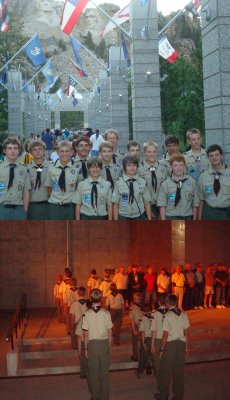 On July 31, the two backpacking crews met at Mt. Rushmore. One crew had just completed it's trek while the second was just beginning. It was interesting to see the 'enthusiasm' of one group and the 'experience' of the other when they got together.
On July 31, the two backpacking crews met at Mt. Rushmore. One crew had just completed it's trek while the second was just beginning. It was interesting to see the 'enthusiasm' of one group and the 'experience' of the other when they got together.After making dinner at the campsite, we arrived at the monument with just enough time to prepare for the evening ceremony. That was disappointing since most of us would have liked to explore a little.
The Ranger discussed the program with the two crew leaders and they walked the gang through the process a couple times. Then, we waited for the ampitheater to fill - and it sure did fill! You can see there was a stage full of Veterans and over 2,000 others in attendance. We met a troop from Los Angeles and a Cub Scout that can hardly wait to join a troop.
To start the program, our SPL led the audience in the Pledge of Allegiance. We then listened to the ranger speak and watched a video. At the end, it was our time to lower the flag.
It went well and each scout did their bit. The SPL gave commands, one scout lowered the flag, each scout held it tight, and a couple folded it.
We hung around about 15 minutes after the ceremony to let all the traffic clear out and then headed to camp to rest up before our long drives the next day - home or to the wilderness.
We stayed at Kemp's Kamp in Keystone, SD which is a very convenient spot for accessing Mt. Rushmore.
If you're interested in lowering the Mt. Rushmore flag, visit Mt. Rushmore homepage and complete an application in January - it fills fast.
Scout On
| Leave Comment |
Posted: 16:21 08-13-2010 514
New Outdoors Awards
 Three new awards for recognizing scouts that really get outdoors are available this summer. Or, I guess you could say it's seven awards.
Three new awards for recognizing scouts that really get outdoors are available this summer. Or, I guess you could say it's seven awards.The National Outdoor Badges recognize a scout's expertise and participation in five categories: Camping, Hiking, Aquatics, Riding, and Adventure. A scout earns the core patch and a segment, then can add the other four segments over time or concentrate on a single category and add gold and silver devices for additional participation.
When a scout accomplishes enough of the Outdoor Badges and wants to push himself a little more, he can earn the National Outdoor Achievement award. Recognition for this award is a medal. I like the requirements of Wilderness First Aid and Leave No Trace training, since that knowledge is vital for the other planning and leading requirements.
Finally, the unit can earn a streamer for its flag by completing the National Outdoor Challenge. The requirements are pretty substantial, requiring summer camp, merit badges, Leave No Trace program, and interaction with Webelos.
I don't know is where this blob of patches, segments, and pins is supposed to go. I suppose it's centered on the right pocket, but I'm pretty sure a plastic patch holder isn't going to cut it. Lots of troops already have segmented patch systems from summer camp on their right pockets - we do anyway.
Scout On
| Leave Comment |
Posted: 16:05 08-12-2010 513
Previous PostsComments:
Feb 25, 2023 - Joe Patterson
Just out of curiosity, are the Rockwell paintings on exhibit anywhere
Mar 16, 2023 - Adam John
Great question Joe! Have you checked out the Norman Rockwell Museum in
Stockbridge MA? (nrm.org) There is also the Rockwell Museum in Corning
NY. (rockwellmuseum.org) I believe the latter has more art. Hope this
helps!
Jan 21, 2024 - Johnna Downing
The Scouting museum at Philmont, Cimmaron, NM hopefully has the ones that
used to hang at the museum in Irving, TX. Good luck. Johnna
Comment or Question about this page:
Scouting 2025 - Ask a Question - Add Content
Just for Fun: Socializing merit badge




This site is not officially associated with Scouting America
Find more Scouting Resources at www.BoyScoutTrail.com



Follow Me, Scouts
Recent Comments